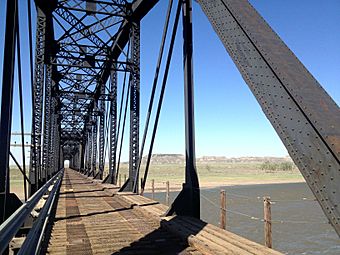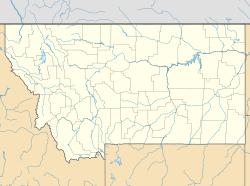Yellowstone River Bridge facts for kids
Quick facts for kids |
|
|
Yellowstone River Bridge
|
|
 |
|
| Location | Milepost 1 on Interstate 94, Fallon, Montana |
|---|---|
| NRHP reference No. | 09001187 |
| Added to NRHP | January 4, 2010 |
The Yellowstone River Bridge is a very important bridge located in Fallon, Montana. It's so special that it's listed on the National Register of Historic Places. This means it's a place worth protecting because of its history. The bridge was added to this special list on January 4, 2010. It's a long bridge, made of steel, and was built a long time ago, between 1943 and 1944. What makes it even more interesting is that it was one of the few big bridges built in Montana during World War II.
The Yellowstone River Bridge
The Yellowstone River Bridge is the longest truss bridge in Montana. It stretches for 1,142 feet! A truss bridge uses a special design with triangles to make it very strong. This bridge is also unique because it was built during World War II. During the 1930s, Montana built many bridges. This was thanks to a program called the New Deal, which helped create jobs. But when World War II started, most building projects stopped. Only roads important for national security kept getting built.
A Bridge Built During Wartime
One of the important roads was U.S. Route 10. This road connected Seattle to Minneapolis. In 1943, a big chunk of ice destroyed the old bridge at Fallon. This meant cars and important war supplies had to drive an extra 55 miles! To fix this problem, the United States Secretary of Defense ordered a new bridge to be built. This new bridge was designed to cross wide rivers. It used a special design called a "Warren through truss." You can tell it's a Warren truss because the steel beams look like "W" shapes.
How the Bridge Was Built
Even though the government said the bridge was important, building it was hard. There weren't enough workers or steel because of the war. Bad weather and high water in the river also slowed things down. The W. P. Roscoe Company of Billings built the bridge. They hired men from the Crow Indian Reservation to help pour the concrete parts. Another company helped put up the steel parts. People watched in amazement as workers walked high up on the beams, 70 feet above the ground. They looked as calm as if they were walking on a normal road! The Yellowstone River Bridge finally opened in late November 1944. It was a big celebration.



